| Srl | Item |
| 1 |
ID:
121677
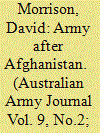

|
|
|
|
|
| Publication |
2012.
|
| Summary/Abstract |
I
t is an honour to address the Sydney Institute. Over more than two decades
Gerard and Anne have cemented the reputation of the Sydney Institute as the
premier forum in this city for the serious discussion of public policy as well as
the arts and culture. Theirs is a considerable achievement, and I am grateful for the
opportunity to deliver my first address to an audience outside Defence as the Chief
of the Army at this Institute. My topic today is the 'Army After Afghanistan.'
|
|
|
|
|
|
|
|
|
|
|
|
|
|
|
|
| 2 |
ID:
121679
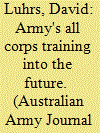

|
|
|
|
|
| Publication |
2012.
|
| Summary/Abstract |
T
he Australian Army currently conducts individual training for soldiers,
non-commissioned officers, warrant officers and officers in two forms: 'All
Corps Training' and 'Corps Specific Training'. As my authorities extend
only over the All Corps Soldier and Officer Training Continuums, it is there
that I will focus my encapsulation of that aspect of Army's professional military
education.
|
|
|
|
|
|
|
|
|
|
|
|
|
|
|
|
| 3 |
ID:
121678


|
|
|
|
|
| Publication |
2012.
|
| Summary/Abstract |
The provision of national security is one of the essential responsibilities of government. As
the Japanese advance neared Australia in early 1942 it became clear that Australia's interwar
political leadership had failed to provide adequately for the nation's security. This article
explains how in 1942 Australia found itself virtually bereft of military power as well as the
steps to remedy the crisis. In doing so, the article questions whether the recent budgetary
decisions by today's political leadership will also result in an Army with a similar degree
of unreadiness, and one that is incapable of meeting the challenges of today national
security environment.
|
|
|
|
|
|
|
|
|
|
|
|
|
|
|
|
| 4 |
ID:
121687
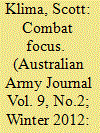

|
|
|
|
|
| Publication |
2012.
|
| Summary/Abstract |
The many pressures and competing requirements of the modern sub-unit commander
can easily see the commander's attention only fleetingly focused on what should be the
primary role of his unit: combat. It is easy for a modern commander in today's corporate
governance-driven training environment to comply with the administrative reporting,
resource management, risk mitigation and non-linear command structure necessities, and
in so doing losing that essential mindset that will enable those he commands to win the
fight. The purpose of this article is to look at what our role should be as soldiers, or more
importantly as commanders of soldiers, as we prepare to fight and survive on the battlefield
of today's hybrid threat environment.
|
|
|
|
|
|
|
|
|
|
|
|
|
|
|
|
| 5 |
ID:
121682


|
|
|
|
|
| Publication |
2012.
|
| Summary/Abstract |
I
n the years since improvised explosive devices (IEDs) became symbols of asymmetric warfare and modern military conflict, very little has changed in the
realm of counter-improvised explosive device (C-IED) strategy. The military
is always searching for better vehicles and equipment to defeat what is, at its core, a
homemade device made for a fraction of the cost of our technological countermeasures. As a result, C-IED strategy has primarily focused on developing new ways to
mitigate the effects of an IED blast rather than trying to prevent it from occurring.
Billions of dollars have been spent in the name of saving lives, yet the true cause
of the problem and its origins remain largely ignored, leaving out the crucial role
played by population-centric counterinsurgency operations.
|
|
|
|
|
|
|
|
|
|
|
|
|
|
|
|
| 6 |
ID:
121681
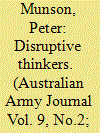

|
|
|
|
|
| Publication |
2012.
|
| Summary/Abstract |
B
enjamin Kohlmann's essay, "The Military Needs More Disruptive Thinkers,"1
struck a chord like no other essay published recently in the Small Wars
Journal. In brutal honesty, I have to say that the many sniping comments
struck exposed flesh. While an ardent fan of Kohlmann's essay, I have to agree that
his argument was more akin to birdshot at maximum range than a mailed fist to
the throat of the problem. Perhaps a better analogy is that his was a marking round
lobbed in the general vicinity of the problematic enemy fire. Whatever it was, it was
a wildly popular read. For all the comments on the article, the one that rang truest
with me came from commener "Null Hypothesis" and asked, "What problem are
we trying to solve again?" This was absolutely the right question.
|
|
|
|
|
|
|
|
|
|
|
|
|
|
|
|
| 7 |
ID:
121680


|
|
|
|
|
| Publication |
2012.
|
| Summary/Abstract |
F
or my generation, there is one profession that captures our imagination more
than any other: Entrepreneur. This is especially true of those leaving the
military and going to business school. It would seem logical for the military
to find ways to blend the best of entrepreneurial and combat cultures in ventures
like a joint Harvard Business School/Naval War College degree program.
|
|
|
|
|
|
|
|
|
|
|
|
|
|
|
|
| 8 |
ID:
121684
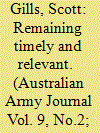

|
|
|
|
|
| Publication |
2012.
|
| Summary/Abstract |
Since 1999, reinvigorated understanding and investment has seen an increase in the effective
use of intelligence and its associated intelligence, surveillance and reconnaissance collection
capabilities during recent operations in the Middle East and South Asia. During this period
Army's intelligence capability has demonstrated agility in tailoring its organisation to meet
evolving expeditionary force requirements-this has been no more evident than during
deployments to Afghanistan. This article examines two key challenges for Army's intelligence capability post-Afghanistan. Initially, it will examine the challenge of introducing
the provision of professional intelligence support to commanders at Army's highest levels in
order to improve synchronisation of effort regarding intelligence activities across the Service.
Secondly, it will review the provision of intelligence support to amphibious operations and
the challenge of preparing personnel for employment within a new capability, while being
constrained by time and a lack of current knowledge, skill and experience.
|
|
|
|
|
|
|
|
|
|
|
|
|
|
|
|